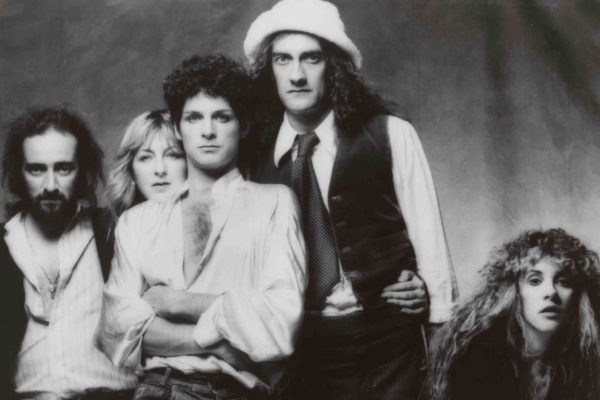It’s hard to imagine a more deliciously dysfunctional band than Fleetwood Mac. Their combination of musical chops and effortless charisma have been compelling the masses for decades and they continue to pick up new fans with each passing year. They’re a profound, timeless delight.
Author and musical historian Don Klees clears up the proverbial musical elephant in the room from the intro of his new book Fleetwood Mac in the ‘80s. Yes, they’re most revered for and associated with 1977’s Rumours. The line-up at the time was Mick Fleetwood, Christine McVie, John McVie, Stevie Nicks, and Lindsey Buckingham. The lyrically lovely, instrumentally ambitious Rumours hit the zeitgeist jackpot in 1977 when these brilliant artists melded their exposed hearts together into an unforgettable LP that everyone found a way to relate to. It’s the 12th best-selling album of all time.
Fleetwood Mac originally formed in 1967 and has gone through many member shifts due to their volatility and complex lives. The core band reunited in 1992 when President Clinton used “Don’t Stop” as his campaign anthem; he prevailed upon them to sing it at his inauguration. Fleetwood Mac continued to meet & part over the years and have only recently presumably split for all time with the sad passing of Christine McVie.
Fleetwood Mac in the ’80s acknowledges all this but its goal is to analyze the band’s joint and solo ventures from 1980 through 1990. All were worthy, but some fared far better than others. While Stevie Nicks maintained the biggest public profile, with her mystical goddess vibe, other members churned out their own albums with varying degrees of commercial and artistic success.
Nicks’ 1981 Bella Donna was a #1 hit practically out of the gate with such classics as “Edge of Seventeen,” “Leather and Lace” (with Don Henley”), and “Stop Dragging My Heart Around” (with Tom Petty and The Heartbreakers), establishing herself as the band’s breakout solo star.
Fleetwood Mac made only two group albums in the 1980s: 1982’s Mirage and 1987’s Tango in the Night. While both fell short of the 40 million+ sales from Rumours, they were legitimate successes by any other commercial standard, going platinum and bringing us memorable tracks like “Hold Me,” “Gypsy” and “Little Lies,” among others.
While there’s no question that Fleetwood Mac operated as a machine of soul, melody, and harmony, their interpersonal woes kept them from consistently cleaving together. Drinking, substance abuse, wrecked romances, and creative differences bedeviled the band for years.
The elegantly written Fleetwood Mac in the ‘80s lays out a lot of these issues with fairness and nuance, utilizing Mick Fleetwood’s two insightful memoirs and interviews from over the years; each bandmate was refreshingly eloquent with the press. The main goal of the book is to honor the musical legacy, singly and otherwise, of Fleetwood Mac during the 1980s.
Each chapter delves into the albums that were released in that decade, opening with the layout of the tracks and stats, followed by perceptive lyrical analyses. The poetry of the band stands out in sharp relief even without the music, and their all-too-human struggles add context to the songs they created.
Fleetwood Mac in the ‘80s provides vibrant photos and brackets their history with a prologue of their early days of inception and an epilogue of their recent years with a sense of balance and humanity. While it’s clear that Don Klees has a love for and fascination with the band, the volume is a provider of truth and edification. It’s neither a puff piece nor a deep dive for prurience. Rather, it honors the history of a band with a long tenure and tightens the lens on the post-Rumours era. Rumours will always be a shining light, but 1980-1990 produced an output of music that deserves to be heard and revisited.
-Ellen Fagan
Photo: Fleetwood Mac (publicity photo)
PS — While we’re on the topic of Rock History, you might enjoy our YouTube series of daily one-minute nuggets of memorable moments…






Nice review.
Nice book. Thanks so much, Eoghan! Sweet Fleetwood Mac overview.
When Peter Green isn’t mentioned once that’s the moment I stop reading
Why would any sensible person expect Peter Green – or any other pre-Buckingham guitarist – to be mentioned in a review of a book about Fleetwood Mac in the 1980s?
Peter Green has always been relevant. Any sensible fan recognizes this. He released several solo records in the 80s… Little Dreamer, White Sky, Kolors, Whatcha Gonna Do, Legend… Highlights are collected in the Man of the World compilation…. Danny Kirwan released Ram Jam City in the early 80s… Bob Welch consistently released material every couple of years until he passed away.
William Whitaker
Green, Kirwan, Welch and even Bob Weston all figure in the book at various points, but the focus is clearly on the people who were actually part of Fleetwood Mac in the 1980s.